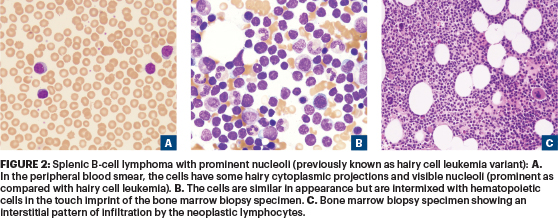The ASCO Post is pleased to present Hematology Expert Review, an ongoing feature that quizzes readers on issues in hematology. In this installment, Drs. Syed Ali Abutalib and L. Jeffrey Medeiros explore the World Health Organization (WHO) classification of hematopoietic and lymphoid tissue malignancies, focusing on splenic B-cell lymphomas and leukemias. For each quiz question that follows, select the one best answer. The correct answers and accompanying discussions appear below.
GUEST EDITORS

Syed Ali Abutalib, MD

L. Jeffrey Medeiros, MD
Dr. Abutalib is Associate Professor; Co--Director, Hematology & BMT/Cellular Therapy; and Medical Director, NMDP Apheresis Midwest Program, City of Hope, Zion, Illinois. Dr. Medeiros is Professor and Chair, Department of Hematopathology, The University of Texas MD Anderson Cancer Center, Houston.
Question 1
According to the WHO 5th edition classification, which of the following entities does not belong to the category of “splenic B-cell lymphomas and leukemias”?
A. Hairy cell leukemia
B. Splenic B-cell lymphoma/leukemia with prominent nucleoli
C. Splenic diffuse red pulp small B-cell lymphoma
D. Splenic marginal zone lymphoma
E. B-cell rolymphocytic leukemia
Question 2
Which of the following statements about B-cell rolymphocytic leukemia is correct?
A. The international consensus classification (ICC) and WHO 5th edition classification are aligned in categorizing B-cell rolymphocytic leukemia.
B. In the WHO 5th edition classification, B-cell rolymphocytic leukemia is no longer recognized as a distinct entity.
C. In the ICC, B-cell rolymphocytic leukemia is no longer recognized as a distinct entity.
D. About 25% of cases of B-cell rolymphocytic leukemia are associated with the CCND1::IGH fusion.
Question 3
Which of the following best describes the bone marrow morphology of rolymphocytic progression of chronic lymphocytic leukemia (CLL)?
A. Nonparatrabecular nodular, interstitial, or diffuse infiltrates of monotonous small round lymphocytes with scant cytoplasm
B. Focal or extensive nonparatrabecular and trabecular nodular or interstitial infiltrates of small- to intermediate-sized lymphocytes with variably condensed chromatin and irregular nuclear contours
C. Focal or extensive paratrabecular infiltrates with variable small cleaved lymphoid cells
D. Interstitial or diffuse infiltrate of intermediate-sized lymphocytes exhibiting round nuclei with relatively condensed nuclear chromatin and prominent central nucleoli
Question 4
According to WHO 5th edition classifications, which of the following features is most consistent with a diagnosis of splenic B-cell lymphoma/leukemia with prominent nucleoli?
A. Splenomegaly and SOX11 expression by neoplastic B lymphocytes
B. Splenomegaly and CD5 and CD23 expression by neoplastic B lymphocytes
C. Splenomegaly and CD25 expression by neoplastic villous B lymphocytes
D. Splenomegaly and CD25-negative neoplastic villous B lymphocytes
Question 5
Which of the following statements about distinguishing between the four entities in the category of splenic B-cell lymphoma and leukemias is/are correct?
A. Splenic diffuse red pulp small B-cell lymphoma has some features overlapping with hairy cell leukemia and splenic B-cell lymphoma/leukemia with prominent nucleoli but can be distinguished by careful evaluation of morphologic and immunophenotypic -characteristics.
B. Bone marrow examination shows characteristic features in splenic diffuse red pulp small B-cell lymphoma with a predominant intrasinusoidal pattern.
C. These entities can be best discriminated by pathologic examination of the spleen.
D. All of the above
Answers to Hematology Expert Review Questions
Question 1
According to WHO 5th edition classification, which of the following entities does not belong to the category of “splenic B-cell lymphomas and leukemias”?
Correct answer: E. B-cell rolymphocytic -leukemia.
Expert Perspective
In the World Health Organization (WHO) 5th edition classification, “splenic B-cell lymphomas and leukemias” is an umbrella term that includes choices A to D.1 The designation splenic B-cell lymphoma/leukemia with prominent nucleoli is a new term and is considered as a holding category that includes cases previously designated as “hairy cell leukemia variant.”
Choice E is the correct answer because B-cell rolymphocytic leukemia is not included among the splenic B-cell lymphomas and leukemias. In fact, B-cell rolymphocytic leukemia is no longer recognized as a distinct entity in the 5th edition of the WHO classification.2 It is currently thought that -prolymphocytoid -transformation can occur in a number of different B-cell neoplasms, most often chronic lymphocytic leukemia (CLL), but also mantle cell lymphoma (characterized by the presence of a CCND1::IGH fusion), splenic marginal zone lymphoma, splenic diffuse red pulp small B-cell lymphoma, and cases of hairy cell leukemia variant now included in the category of splenic B-cell lymphoma/leukemia with prominent nucleoli (Figure 1).
Question 2
Which of the following statements about B-cell rolymphocytic leukemiais correct?
Correct answer: B. In the WHO 5th edition classification, B-cell rolymphocytic leukemia is no longer recognized as a distinct entity.
Expert Perspective
The International Consensus Classification (ICC) continues to recognize B-cell rolymphocytic leukemia as a very rare entity, in contrast with the 5th WHO classification. The ICC recommends the diagnosis of B-cell rolymphocytic leukemia be established only in patients without a history of B-cell CLL (to exclude CLL progressing to B-cell rolymphocytic leukemia), negative for cyclin D1 and SOX11 (to exclude mantle cell lymphoma), and lacking hairy surface projections and intrasinusoidal bone marrow infiltration (to exclude hairy cell leukemia variant, splenic marginal zone lymphoma, and splenic diffuse red pulp small B-cell lymphoma).3
Until about the year 2000, approximately 25% of cases of B-cell rolymphocytic leukemia were described as being associated with the CCND1::IGH fusion. These cases are currently considered to be prolymphocytoid transformation of mantle cell lymphoma.1-3
Question 3
Which of the following best describes the bone marrow morphology of rolymphocytic progression of chronic lymphocytic leukemia?
Correct answer: D. Interstitial or diffuse infiltrate of intermediate-sized lymphocytes exhibiting round nuclei with relatively condensed nuclear chromatin and prominent central nucleoli.
Expert Perspective
B-cell prolymphocytoid transformation of CLL (or other B-cell neoplasm) or B-cell rolymphocytic leukemia (as defined by the ICC) is a neoplasm involving the peripheral blood, bone marrow, and spleen. The cells are intermediate-sized (twice the size of a normal lymphocyte) with a round nucleus, moderately condensed nuclear chromatin, a prominent central nucleolus, and a moderate amount of faintly basophilic cytoplasm.4 Although the nucleus is typically round, in some cases, it can be indented. The bone marrow core biopsy specimen usually shows an interstitial or diffuse infiltrate of lymphoid cells. Choices A, B, and C best describe the morphology of CLL, mantle cell lymphoma, and follicular lymphoma, respectively, in the bone marrow.
Question 4
According to WHO 5th edition classifications, which of the following features is most consistent with a diagnosis of splenic B-cell lymphoma/leukemia with prominent nucleoli?
Correct answer: D. Splenomegaly and CD25-negative neoplastic villous B lymphocytes.
Expert Perspective
According to the WHO 5th edition classification,1 choice D favors the diagnosis of splenic B-cell lymphoma/leukemia with prominent nucleoli (Figure 2). Choices A, B, and C would favor the diagnosis of mantle cell lymphoma, CLL, and hairy cell leukemia (mutant BRAF ≥ 95% of cases), respectively. The category of splenic B-cell lymphoma/leukemia with prominent nucleoli has absorbed cases formerly classified as hairy cell leukemia variant (splenomegaly and CD25-negative neoplastic villous B lymphocytes). It should be noted that the distinction between the various splenic B-cell lymphomas and leukemias cannot always be made in the absence of a splenectomy specimen.
Question 5
Which of the following statements about distinguishing between the four entities in the category of splenic B-cell lymphoma and leukemias is/are correct?
Correct answer: D. All of the above.
Expert Perspective
Splenic diffuse red pulp small B-cell lymphoma has some features overlapping with hairy cell leukemia and splenic B-cell lymphoma/leukemia with prominent nucleoli but can be distinguished on careful evaluation of morphologic and immunophenotypic characteristics. A CD200 mean fluorescence intensity/CD180 mean fluorescence intensity ratio less than 0.5 on flow cytometry favors a diagnosis of splenic diffuse red pulp small B-cell lymphoma over hairy cell leukemia, splenic marginal zone lymphoma, and splenic B-cell lymphoma/leukemia with prominent nucleoli.1,4


These entities can be best discriminated by pathologic examination of the spleen; in the absence of a splenectomy specimen, bone marrow examination provides some clues. Cases of splenic diffuse red pulp small B-cell lymphoma often show a predominantly intrasinusoidal pattern. Cases in the splenic B-cell lymphoma/leukemia with prominent nucleoli category usually show a more diverse growth pattern in the bone marrow, and hairy cell leukemia shows a typical diffuse pattern with reticulin fibrosis.1,5 When in doubt, use of the term splenic B-cell lymphoma/leukemia, unclassifiable, is warranted.
DISCLOSURE: Dr. Abutalib has served on the advisory board for AstraZeneca. Dr. Medeiros reported no conflicts of interest.
REFERENCES
1. Alaggio R, Amador C, Anagnostopoulos I, et al: The 5th edition of the World Health Organization classification of haematolymphoid tumours: Lymphoid neoplasms. Leukemia 36:1720-1748, 2022.
2. El Hussein S, Khoury JD, Medeiros LJ: B-prolymphocytic leukemia: Is it time to retire this entity? Ann Diagn Pathol 54:151790, 2021.
3. Campo E, Jaffe ES, Cook JR, et al: The international consensus classification of mature lymphoid neoplasms: A report from the Clinical Advisory Committee. Blood 140:1229-1253, 2022.
4. Favre R, Manzoni D, Traverse-Glehen A, et al: Usefulness of CD200 in the differential diagnosis of SDRPL, SMZL, and HCL. Int J Lab Hematol 40:e59-e62, 2018.
5. Angelova EA, Medeiros LJ, Wang W, et al: Clinicopathologic and molecular features in hairy cell leukemia-variant: Single institutional experience. Mod Pathol 31:1717-1732, 2018.

